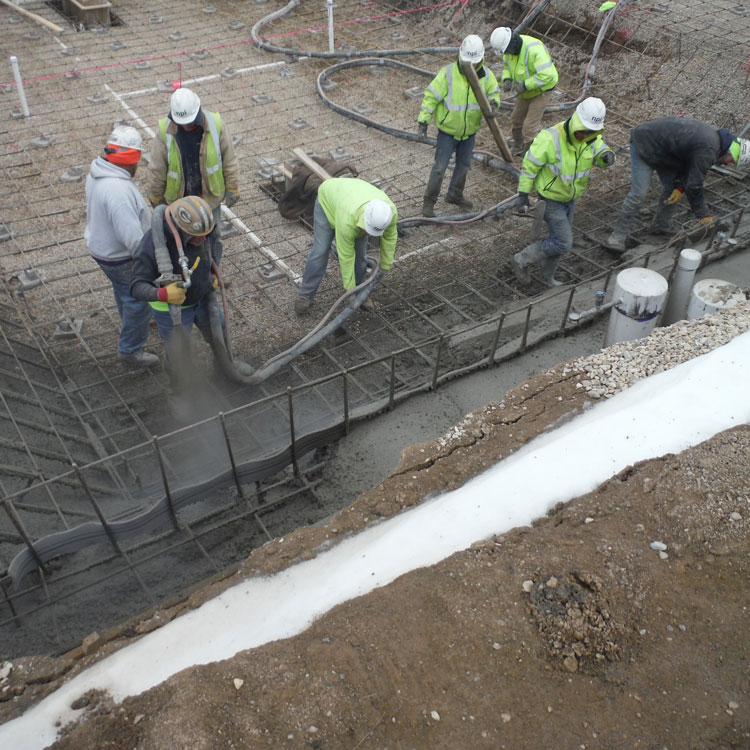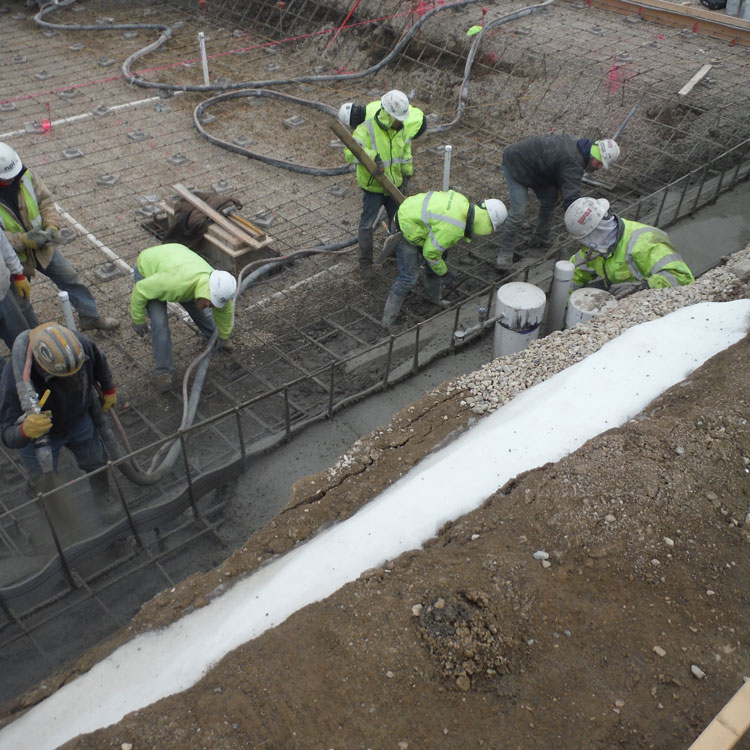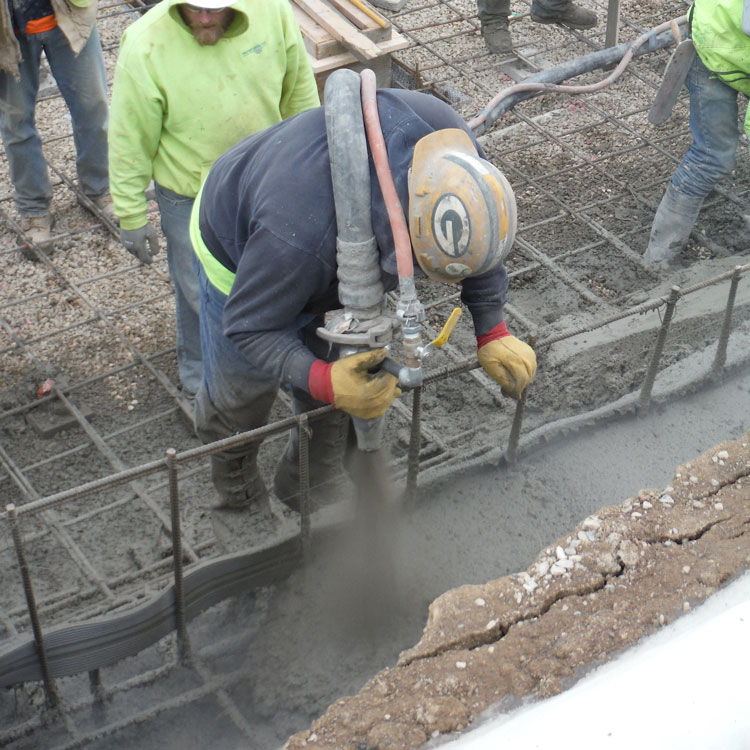
Article and photos by Gregory Havel
When we think of concrete, we usually think of a mixture of gravel, sand, Portland cement, and water that is poured into forms and allowed to set and cure.
Another method of concrete placement is by “gunning,” which refers to pumping the concrete to a nozzle and using compressed air to blow it into place under pressure. This process can be used on floor slabs, walls, and overhead surfaces like ceilings and roofs.
There are two ways that concrete can be placed using this method:
- Dry-mix, or “gunite,” places the dry concrete ingredients (gravel, sand, and Portland cement) in a hopper and carries them with compressed air through a hose to the nozzle. Here water is added, and workers spray the concrete mixture onto the surface that has been prepared. This is a topic for another time.
- Wet-mix, or “shotcrete,” places ready-mixed concrete (sometimes with reinforcing fiber added) into a hopper, pumps the concrete through a hose to the nozzle. Here compressed air is injected, and a worker sprays the concrete onto the surface that has been prepared. This is the more common process in the late 20th and 21st centuries.
- Sometimes the terms “gunite” and “shotcrete” are used interchangeably, although the processes are different.
This article will discuss the wet-mix method of shotcrete.
Among the advantages of shotcrete over poured concrete are:
- It does not need a complex system of forms like the more familiar poured-in-place concrete, since it is applied as a stiff paste and needs only a one-sided form, or none at all if it is applied over compacted soil
- It requires no vibration or compaction after placement, since it is blown into place under pressure
- It is an inexpensive way to build concrete in curves and irregular shapes that are difficult or impossible with conventional concrete forming, such as those needed in tanks, domes, swimming pools, and skate parks
- It can be used with steel reinforcing bars, welded wire reinforcing mesh, fiber reinforcement mixed with the concrete, or with no reinforcement
- It has the same non-combustible and fire-resistive qualities as concrete that has been formed and poured in the conventional manner.
The primary disadvantage of shotcrete compared to poured concrete is the amount of time that it takes when used for large foundations, structural piers, and other structures with large cross-sections, compared to using conventional forms for these large structures.
Two common problems when applying shotcrete are gravel in the concrete aggregate that is too large, which interferes with the spraying of the concrete; and ready-mixed concrete that is too wet (too great a slump), so that it does not stick well to vertical and overhead surfaces.
Concrete applied by shotcrete often incorporates steel reinforcing bars. Photo 1 shows the bottom and sides of the deep end of a large municipal swimming pool. The shotcrete crew is standing on the steel reinforcing for the bottom of the pool, which is supported by concrete masonry units resting on compacted soil. This steel reinforcement will be completely embedded in the concrete when the procedure is done, as it is at the rear of the photo near the top of the wall.

(1)
Photo 2 shows another view of the crew, with the nozzleman at the left, the hose-handlers in the center, and finishers with hand trowels at the far left. Also visible are the two hoses leading to the nozzle. The larger hose contains concrete and is connected to the concrete pump at the top of the embankment, near the ready-mix truck. The smaller hose is connected to a large, trailer-mounted air compressor, to supply the compressed air to blow the concrete into place.

(2)
Photo 3 is another view of the crew, with a better view of the concrete finishers on the right.

(3)
Photo 4 is a close-up of the shotcrete nozzle, with its connection to the hose from the concrete pump, and the compressed air valve and hose connection to the air compressor. By adjusting the compressed air valve, the nozzleman can control the velocity with which the concrete is discharged. The volume of concrete that is discharged is controlled at the concrete pump.

(4)
The shotcrete is usually hand-troweled in close quarters, as shown in the photos, and on walls and ceilings. On large, flat, open areas, like floors and the bottoms of swimming pools, the finishing may be done with troweling machines as with conventionally poured concrete.
On very large shotcrete jobs, the hoses and nozzle may be carried by a robotic boom operated by remote control.
For more information on shotcrete and its processes:
- Search the Internet for “shotcrete” and “gunite”
- Visit https://www.shotcrete.org
- Visit http://www.shotcrete.us
For information on the mixers, pumps, and other machines used in the shotcrete process, search the Web for “shotcrete machine”
Download this article as a PDF HERE (2.7 MB).
 Gregory Havel is a member of the Town of Burlington (WI) Fire Department; retired deputy chief and training officer; and a 35-year veteran of the fire service. He is a Wisconsin-certified fire instructor II, fire officer II, and fire inspector; an adjunct instructor in fire service programs at Gateway Technical College; and safety director for Scherrer Construction Co., Inc. Havel has a bachelor’s degree from St. Norbert College; has more than 35 years of experience in facilities management and building construction; and has presented classes at FDIC International. This year ihe is presenting on “Building Construction and Fire Behavior.”
Gregory Havel is a member of the Town of Burlington (WI) Fire Department; retired deputy chief and training officer; and a 35-year veteran of the fire service. He is a Wisconsin-certified fire instructor II, fire officer II, and fire inspector; an adjunct instructor in fire service programs at Gateway Technical College; and safety director for Scherrer Construction Co., Inc. Havel has a bachelor’s degree from St. Norbert College; has more than 35 years of experience in facilities management and building construction; and has presented classes at FDIC International. This year ihe is presenting on “Building Construction and Fire Behavior.”
MORE CONSTRUCTION CONCERNS

